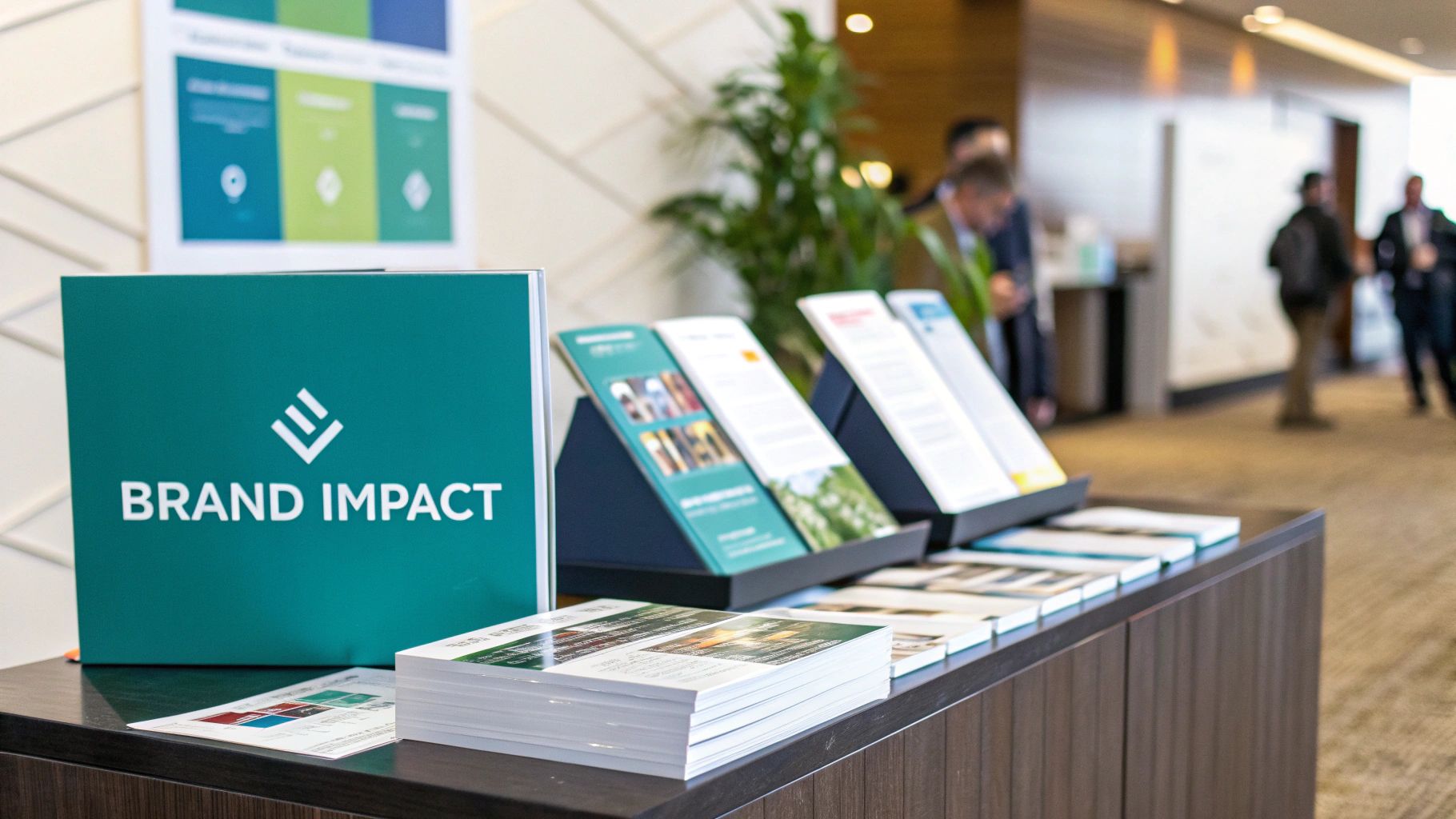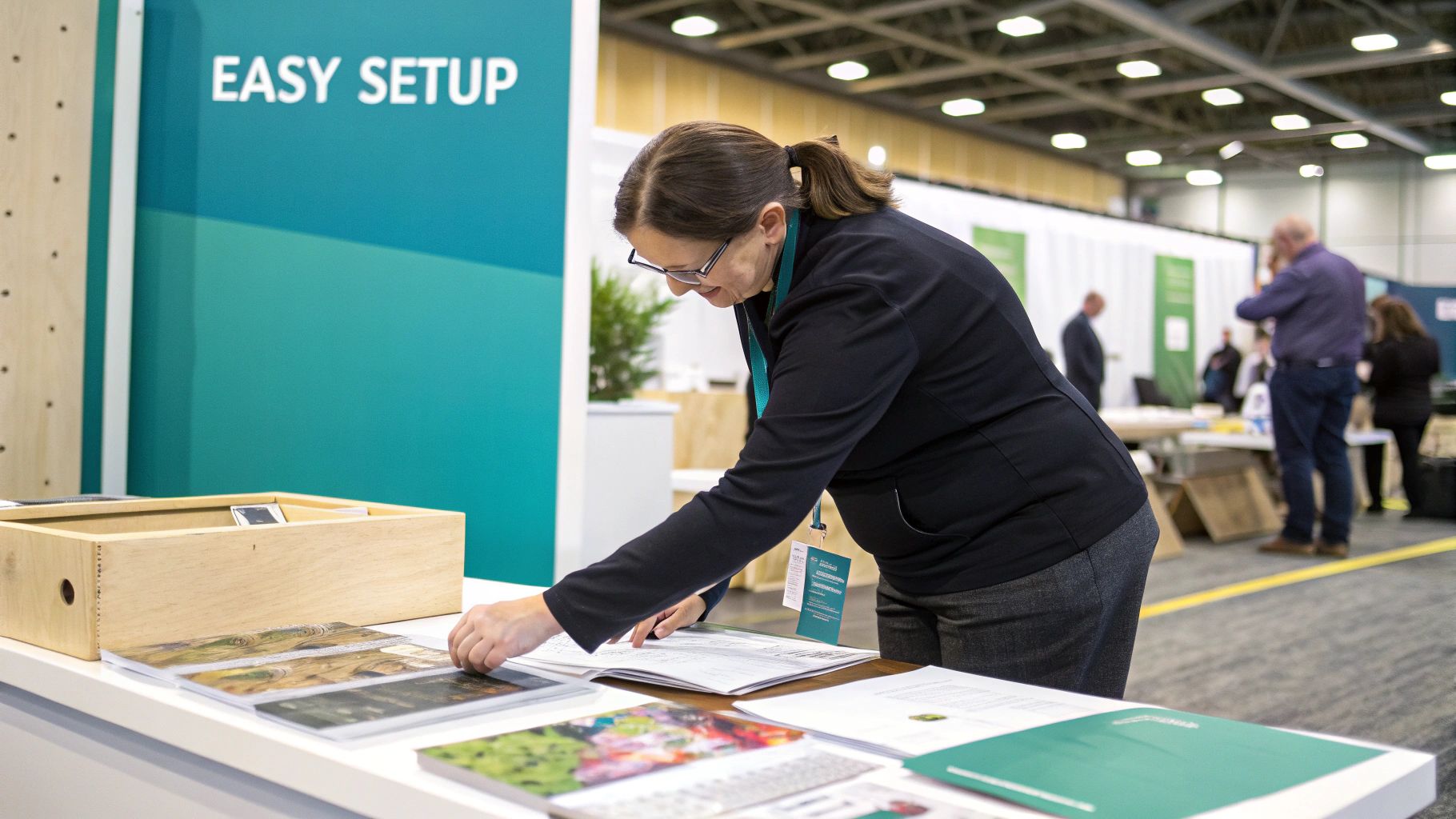Making a significant impact at a trade show doesn't always require the largest booth on the floor. For marketing managers and exhibit coordinators tasked with maximizing ROI, a tabletop trade show exhibit can be a powerful secret weapon—a compact, portable, and cost-effective solution for creating focused, high-quality connections. Think of it less as a compromise and more as a smart, strategic business move.
When a Tabletop Exhibit Is Your Smartest Move
For marketing managers juggling tight budgets and even tighter floor plans, the idea of "going small" can feel counterintuitive. But choosing a tabletop exhibit is often a calculated move that pays off, delivering an impressive return on investment. Instead of seeing it as a limitation, think of it as a tool for precision and efficiency in a loud, crowded event hall.
This approach allows your brand to present a professional image without the logistical headaches and heavy costs associated with larger, more complex booths. It's the perfect solution for specific situations where being nimble and focused is the key to achieving your event goals.
When Does a Tabletop Display Make the Most Sense?
Certain scenarios are tailor-made for the compact power of a tabletop display. Knowing when to deploy one ensures your marketing dollars are working as hard as possible to hit your objectives.
You should seriously consider this format if you are:
- Dipping a Toe into a New Market: Launching a product in a new city or region? A tabletop setup is a low-risk way to test the waters, gather feedback, and assess opportunities without a major financial commitment.
- Attending Niche or Regional Events: For smaller, hyper-focused industry meetups, a massive booth can feel over-the-top. A tabletop exhibit fits the scale and intimate atmosphere of these events perfectly, allowing for more personal engagement.
- Supporting a Larger Presence: If your company already has a flagship booth at a national show, a tabletop display works brilliantly at smaller, simultaneous events or as a secondary information point to capture more traffic.
- Working with a Lean Budget: When every dollar counts, a tabletop exhibit provides a polished, professional look for a fraction of the cost of a 10×10 space. This frees up budget for other critical elements, like travel for your top sales talent.
The real magic of a compact display is how it forces clarity. With limited real estate, you must distill your message to its most powerful, compelling core. Every word and graphic has to earn its place.
The Strategic Edge of Thinking Small
The benefits extend far beyond cost savings. The very nature of a tabletop exhibit gives your team a unique edge. Its portability, for one, is a game-changer. For a deeper look, you can explore the tactical benefits of portable trade show displays in our detailed guide.
Ultimately, a tabletop trade show exhibit excels because it facilitates one-on-one, meaningful conversations. It breaks down physical barriers, putting your team and your product front and center. This creates a welcoming, accessible space that invites attendees to step in and engage directly with your experts.
Building Your Tabletop Exhibit Strategy

Before you consider fonts or color schemes, you need a rock-solid strategy for your tabletop trade show exhibit. Too many beautiful displays end up as expensive table decorations because they lack a clear purpose. The exhibitors who consistently win are those who know exactly what they want to achieve long before setting foot in the venue.
This means moving beyond vague goals like "increasing brand awareness." While important, it isn't measurable and won't drive your decisions. A powerful strategy is built on specific, tangible outcomes that act as a North Star for everything from graphic design to staff training.
Defining Your Primary Objectives
What does a successful outcome look like for this specific event? Your answer will shape the entire design and function of your tabletop exhibit. Instead of thinking broadly, get specific. What would a successful day on the show floor actually produce for your business?
Your goals should be a combination of specific, measurable targets. For instance, are you aiming to:
- Capture 50 qualified leads? This goal immediately prioritizes a fast, efficient lead capture system, such as a tablet with a simple form.
- Schedule 10 on-the-spot product demos? This objective means your display needs a dedicated, accessible demo area and clear signage inviting people to see your product in action.
- Gauge interest in a new service concept? In this case, your focus shifts to conversation-starting graphics and perhaps a simple poll or survey for visitors to interact with.
By choosing one or two primary goals, you create immense focus. It simplifies every decision and ensures that every element, from your main banner to the swag you hand out, serves a distinct purpose.
A well-defined strategy is the filter through which all other decisions should pass. If a design element or piece of equipment doesn't directly support your primary objective, it probably doesn't belong on your table.
Aligning Your Message with Your Goals
Once your objectives are locked in, your core message must support them perfectly. Think of this message as the headline for your entire exhibit—the single idea an attendee needs to absorb in the three seconds they glance at your space.
If your goal is capturing leads for your sales team, a generic brand slogan won't be effective. Instead, you need a benefit-driven statement that addresses a prospect's pain point, like "Cut Your Reporting Time in Half." That's a message that makes a qualified person stop and listen.
Likewise, if you want to schedule demos, your main message might be as direct as "See It Live: A 5-Minute Demo." It’s a clear call to action that directly supports your objective. Every word on your display is valuable real estate; a focused strategy ensures you use it wisely to generate real results. This is how you turn a compact space into a powerful business-generating machine.
Choosing Your Display Hardware and Materials

With your strategy locked in, it's time to select the physical components of your tabletop trade show exhibit. The hardware and materials you choose are the foundation of your setup. They not only affect how your booth looks but also determine its durability and ease of setup.
Think of it as a balancing act between visual impact, portability, and durability. Getting this right from the start is an investment that pays dividends show after show, especially when considering options like our versatile modular displays.
The first major decision most marketing managers face is the classic choice between modern fabric displays and traditional, rigid panel systems. Each has distinct advantages that suit different brands and event schedules.
Fabric Displays: The Modern Choice
Tension fabric displays have become a staple on the trade show floor, and for good reason. They typically consist of a lightweight aluminum pop-up frame with a custom-printed fabric graphic stretched tightly over it, creating a smooth, professional, and seamless look.
Key advantages include:
- Portability: Their primary benefit. They are incredibly lightweight and pack down into a single, easy-to-manage carrying case, eliminating the need for freight shipping.
- Visual Appeal: Dye-sublimation printing infuses color directly into the fabric, resulting in rich, vibrant graphics that won’t peel or crack. The matte finish also prevents glare from harsh overhead lighting.
- Easy Setup: One person can typically set up the frame and attach the graphic in minutes—a lifesaver when time is tight.
The main consideration is that fabric can wrinkle or stain if not packed carefully. Our guide on fabric vs. vinyl displays offers a deeper dive into which material best stands the test of time.
Panel Systems: The Durable Classic
Alternatively, traditional panel systems are the workhorses of the industry. Built from a series of rigid panels (often PVC) that connect to form a solid back wall, they have been a reliable choice for years due to their toughness.
Their biggest selling point is durability. Panel displays can withstand the rigors of a demanding event schedule. They also allow you to mount shelves, monitors, or product displays directly onto the panels. The trade-off is that they are heavier and can be more complex to assemble than a simple pop-up frame.
A Note on Sustainability
The materials you choose reflect your brand's values. Increasingly, event marketers are considering their environmental footprint. In fact, it's estimated that by 2025, a massive 92% of exhibitors will actively seek to use reusable stands and sustainable materials. This is a fundamental shift toward modular designs and lightweight materials that reduce waste and shipping emissions.
Choosing hardware made from recycled aluminum or graphics printed on eco-friendly fabrics isn't just good for the planet—it resonates with a growing number of conscious business partners and attendees.
Whether you land on a dynamic fabric display or a rugged panel system, focus on quality. A well-built, modular system can be a long-term asset, allowing you to reconfigure your tabletop exhibit for different booth sizes or expand it in the future, maximizing your investment.
Designing Graphics That Command Attention
Picture the trade show floor: a bustling environment where you have three seconds—at most—to capture an attendee's attention. In that brief window, the graphics of your tabletop trade show exhibit must do all the heavy lifting. They need to communicate who you are, what you do, and why someone should stop.
A common mistake is trying to cram too much information onto one backdrop. The display becomes a messy collage of text, bullet points, and competing images. It's overwhelming, confusing, and encourages attendees to keep walking. The secret isn't adding more; it's being strategic about what you leave out.
Embrace the "Less is More" Mindset
A clean, focused design will always outperform a cluttered one. Your primary job is to establish a clear visual hierarchy. Think of it as creating a roadmap for the attendee's eyes, guiding them directly to the most important takeaway. It must function like a highway billboard—legible and understandable in a flash.
To achieve this, focus on three key elements:
- A Punchy Headline: This is your value proposition, distilled into five to seven powerful words. Avoid generic corporate taglines. A headline like "Cut Your Invoicing Time in Half" is a hook; "Innovative Solutions for a New Generation" is noise.
- Clear, Confident Branding: Your logo should be prominent, typically at the top of your display. Make it large, clean, and instantly recognizable.
- A Single, Powerful Image: Use one or two high-resolution photos that tell a story or showcase your product compellingly. Avoid generic stock photos at all costs.
This disciplined approach ensures your message lands instantly. You aren’t just hoping people will stop; you're giving them a compelling reason to.
Get the Technical Details Right
Details like colors and fonts can completely change how your booth is perceived from a distance. Your color scheme should align with your brand, but you also need to consider contrast. Bold, bright colors are great for attracting attention, but they shouldn't overpower your message.
Fonts are another area where designs often falter.
Go with a clean, sans-serif font like Helvetica or Arial for your main headline. They were designed for readability at a distance. Using a complex script or a detailed serif font is a recipe for an illegible mess.
Don't underestimate the power of good aesthetics. A recent study revealed that 48% of exhibitors believe an eye-catching design is their most effective tool for attracting visitors. And considering 81% of attendees have buying authority, you absolutely want to pull in those key decision-makers. You can dig into more trade show statistics to see just how much design matters.
When you nail both your message and your visuals, your graphics become your most effective salesperson, working nonstop to draw the right people to your table.
Using Technology to Engage and Interact

A modern tabletop trade show exhibit is more than a static backdrop. By thoughtfully incorporating technology, you can transform a small space into an experience that draws people in and keeps them engaged. The key is to use tech that clarifies your message and enhances the visitor's journey, not complicates it.
The goal isn't just to add gadgets for their own sake. It's about solving a problem or creating an opportunity. For example, a simple, well-placed tablet can revolutionize your lead capture process. Instead of fumbling with paper forms and business cards, you have a clean digital interface that sends leads directly to your CRM. It's smoother, faster, and more professional.
Practical Tech for a Compact Footprint
You don’t need a huge budget or an IT team on standby to make your tabletop display feel current and interactive. Some of the simplest tools can have the biggest impact on how people perceive and remember your brand.
Here are a few ideas that work wonders in tight spaces:
- Mount a Monitor for Looping Video: A small, sleek monitor playing a short brand video or product demo on a loop acts as an extra salesperson. It's an automated storyteller, communicating your value even when your team is busy with other visitors.
- Use QR Codes for Deeper Dives: A QR code on your display can link to a detailed case study, a video testimonial, or a product spec sheet. This gives interested attendees a direct path to more information without having to wait, respecting their time.
- Incorporate Interactive Tablets: Handheld tablets are incredibly versatile. Use one for a quick, one-on-one product walkthrough, run a simple poll to break the ice, or let visitors scroll through your entire product catalog right at the table.
The best technology doesn’t scream for attention. It works quietly in the background to make it easier for people to connect with your brand and quickly grasp what you're all about.
Bridging the Physical and Digital Divide
Trade shows are no longer just in-person events. With hybrid and virtual formats now commonplace, your tech choices can create a seamless experience between the show floor and the screen. Virtual platforms are reshaping what's possible, even for a tabletop display.
While live events have made a strong comeback, about 21% of events worldwide are still happening exclusively online. This shift means exhibitors are getting smarter about investing in tech that works for both physical and virtual audiences. By thinking this way, your tabletop trade show exhibit becomes a central hub for a larger, more integrated event strategy.
For instance, the looping video on your monitor can be the same one featured in your virtual booth profile, creating a consistent brand message. The QR codes on your table can be shared on your digital event page, funneling everyone to the same valuable content.
If you're looking for more inspiration, we have a whole guide on making your trade show booth more engaging without a bigger footprint. This approach ensures every piece of tech you bring delivers maximum value, whether someone is standing right in front of you or logging in from halfway across the world.
A well-executed tabletop exhibit is a powerful tool for making meaningful connections and driving business growth. By focusing on a clear strategy, smart design, and the right hardware, you can stand out on any trade show floor.
Ready to build a tabletop exhibit that turns heads and drives results? The team at Storm Displays has the expertise to guide you toward the perfect setup for your next event.
Explore our full range of trade show display options or contact us today to request a quote and start planning.

